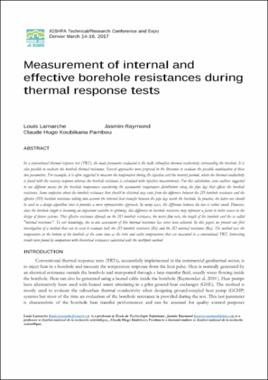| dc.contributor.author | Lamarche, Louis | |
| dc.contributor.author | Raymond, Jasmin | |
| dc.contributor.author | Koubikana Pambou, Claude Hugo | |
| dc.contributor.other | IGSHPA Technical/Research Conference and Expo (2017) | |
| dc.date.accessioned | 2017-03-06T15:38:18Z | |
| dc.date.available | 2017-03-06T15:38:18Z | |
| dc.date.issued | 2017 | |
| dc.identifier | oksd_igshpa_2017_Lamarche | |
| dc.identifier.uri | https://hdl.handle.net/11244/49322 | |
| dc.description.abstract | In a conventional thermal response test (TRT), the main parameter evaluated is the bulk subsurface thermal conductivity surrounding the borehole. It is also possible to evaluate the borehole thermal resistance. Several approaches were proposed in the literature to evaluate the possible combination of these two parameters. For example, it is often suggested to measure the temperature during the injection and the recovery periods, where the thermal conductivity is found with the recovery response whereas the borehole resistance is calculated with injection measurements. For this calculation, some authors suggested to use different means for the borehole temperature considering the asymmetric temperature distribution along the pipe legs that affects the borehole resistance. Some confusion about the borehole resistance that should be obtained may come from the difference between the 2D borehole resistance and the effective (3D) borehole resistance taking into account the internal heat transfer between the pipe legs inside the borehole. In practice, the latter one should be used in a design algorithm since it provides a more representative approach. In many cases, the difference between the two is rather small. However, since the borehole length is becoming an important variable to optimize, this difference in borehole resistance may represent a factor to better assess in the design of future systems. This effective resistance depends on the 2D borehole resistance, the water flow rate, the length of the borehole and the so called "internal resistance." To our knowledge, the in-situ assessment of this internal resistance has never been achieved. In this paper, we present our first investigation of a method that can be used to evaluate both the 2D borehole resistance (Rb) and the 2D internal resistance (Ra). The method uses the temperature at the bottom of the borehole at the same time as the inlet and outlet temperatures that are measured in a conventional TRT. Interesting results were found by comparison with theoretical resistances calculated with the multipole method | |
| dc.format | application/pdf | |
| dc.language | en_US | |
| dc.publisher | International Ground Source Heat Pump Association | |
| dc.rights | In the Oklahoma State University Library's institutional repository this paper is made available through the open access principles and the terms of agreement/consent between the author(s) and the publisher. The permission policy on the use, reproduction or distribution of the article falls under fair use for educational, scholarship, and research purposes. Contact Digital Resources and Discovery Services at lib-dls@okstate.edu or 405-744-9161 for further information. | |
| dc.subject | ground source heat pump systems | |
| dc.subject | thermal conductivity | |
| dc.subject | geothermal engineering--mathematical models | |
| dc.title | Measurement of internal and effective borehole resistances during thermal response tests | |
| osu.filename | oksd_igshpa_2017_Lamarche.pdf | |
| dc.identifier.doi | 10.22488/okstate.17.000539 | |
| dc.type.genre | Conference proceedings | |
| dc.type.material | Text | |
